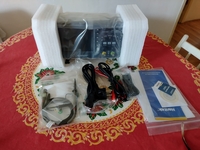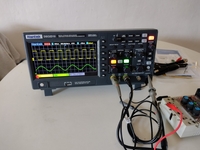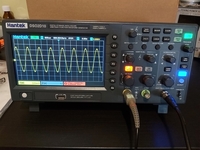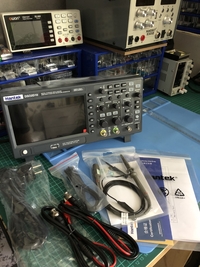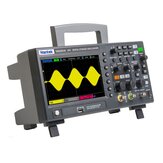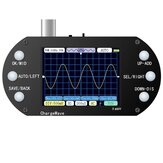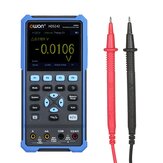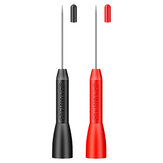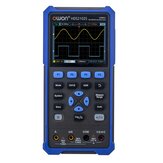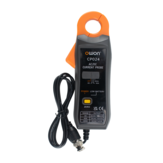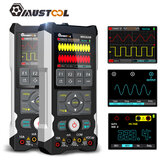- Minden vélemény (201)
- Kép (31)
- Videó (0)
A felülvizsgálat egy részét automatikusan lefordították.
-
26/11/2021
Egy jó kezdők távcső, de ha a pénz megy egy merev og siglent távcső! Így nem kell frissítenie a hatókörét, ha fejlettebb felhasználóvá válik. Csak emlékezzen, hogy vegyen egy másik szondát, mert csak egy van hozzá. Javaslom a pp- 150-et. Is, ne fáradjon a vásárlás a 150mhz modell, mint akkor csapkod ezt 150mhz könnyen, a pp- 150 szondák is jó akár 150mhz. Azt is javasoljuk, hogy adjunk hozzá egy ventillátort a készüléken belül és hűtőbordákat a két chip belsejében. Így idővel következetesebb lesz, mivel a magasabb hőmérsékletek nem okoznak sodródást az idővel. Ily módon is OC ez, és kap többet ki a fft, és úgy fog viselkedni, mint lendületesebb. Egy David Alfa nevű fickó csinálta ezeket a hackeléseket, megtalálhatod az YT csatornáján vagy az EEV fórumon. Az egyik videóján van egy link a google meghajtójához, ahol a különböző hackek szerepelnek! Az utolsó három kép látható, hogy én hozzá egy ventillátort a 5v sín a psu, és hogy használtam egy anyát és csavart, hogy csatlakoztassa a chipek a fém tok jobb hőátadás néhány termikus paszta. Szállítás is nagyon gyors!
Hozzászólások (4)Mutasd az eredetit -
24/12/2020
Early days to give a complete appraisal, however did get familiar over these few days, and I would say it's not too bad for a budget Digital Oscilloscope and signal generator. The display is visually good clear and bright, Graticule and signal wave-forms provide the correct readings, also the read-outs are very close to the known input level; calibration also is spot-on. Can't check the maximum band-width frequency, but suspect it might not go to 100Mhz ? The built-in Generator is okay seems to give the right frequency and level output, and is useful if you are lacking this equipment, so a Two-In-One has benefits at a good price. Y Channel rotary controls can be odd on first encounter, they operate from a fast or slow rotation, can be a little irritating, but once you realise that's how they work, you just take it on-board; however you can set them for Slow rotation, but that can be even more frustrating; my thoughts are, best to leave them as you receive the Oscilloscope, in default mode. Deep Memory is enough for this Scope, was not able to see any really bad sample steps on a sine-wave, at 25Mhz; but this may be more noticeable at higher frequencies, again I can't test that high to check. Again once you become familiar with the buttons and how it operates, life working with the Scope becomes second nature, there are some short cuts you start to remember form operating it over time... my recommendation is, you play with it, to get that experience, and in the course of seeing the odd things that bugs you, they resolve into a working relationship. I would also recommend that once you have received it, you power-up the Scope only after it's been in your home for half an hour, just to get to room temperature; then go to the utility button and select Calibrate, and let it do that; if there is any issues it would resolved at that point. So far, I am happy with it... this has been a long journey to wait for Digital Oscilloscope, with good refresh rate.
Hozzászólások (1)Mutasd az eredetit -
18/09/2021
Még tanulom az elektronikát, szóval még van mit tanulnom a távcső használatáról. Azonban abból, amit tudok, azt mondhatom, hogy ez egy nagyszerű kezdőkörnek tűnik. Kapsz egy nagy csomó funkciók egy nagyon jó áron. A fotók azt mutatják, hogy a távcső megjelenítő 5kHz hullám egy olcsó jel Gen (sárga) együtt ugyanaz 5kHz a belső func generátor (zöld). A második kép az egymás ellen XY módban ábrázolt két jel. A koax hosszát is sikeresen megmértem vele, ami bizonyítja a pontosságát az nS-ig. Kapott egy horgonyt a szállításban, ami valójában lyukat hagyott a dobozon. Szerencsére a távcső nem sérült meg. Bárcsak két szondát szállítottak volna, nem pedig azokat a haszontalan BNC-t a krokodil vezetékekhez. Mindent egybevetve nagyon elégedett vagyok vele.
Hozzászólások (2)Mutasd az eredetit -
12/05/2021
Very well packaged. It comes with sonde probe, two bnc to crocks adapters and usb cable. First turn on device is fast boot and very high quality screen. Signal generator works as expected and it has all feauture in software unlocked. I highly recommended buying this oscilloscope because it is currently best buy for DIY electronics and repair equipment.
Hozzászólások (1)Mutasd az eredetit -
28/03/2022
Nagyon gyorsan szállítják 3 nap alatt. Kipróbált és működőképes. Nagyon jó termék. Köszönöm!
HozzászólásokMutasd az eredetit -
30/12/2021
It arrived fast, in its original box, no bag.. did a quick test, it looks a lot better then the Hantek DSO5072P not sure it can do 100 MHz, analog maybe but rise time wise we will have to see. Full Review later on my YT channel: Tony Albus
Hozzászólások (3)Mutasd az eredetit -
 GrawensHU06/09/2021
GrawensHU06/09/2021Kiváló termék, ajánlom mindenkinek! Ár-érték arány a legjobb. Gyors szállítás.
HozzászólásokMutasd az eredetit -
 roselinyVIP4BG10/05/2022
roselinyVIP4BG10/05/2022super
HozzászólásokMutasd az eredetit -
29/04/2022
Minden megérkezett a sorrendben, és minden működik eddig, szuper eszköz szuper áron. Köszönöm, Bummjó
HozzászólásokMutasd az eredetit -
 ZvikaVIP4IL22/12/2020
ZvikaVIP4IL22/12/2020Kevesebb, mint 3 hét alatt érkezett. A kezdeti vizsgálatok után - csak csodálatos termék. Tele van sok ha funkcionalitással.
HozzászólásokMutasd az eredetit












